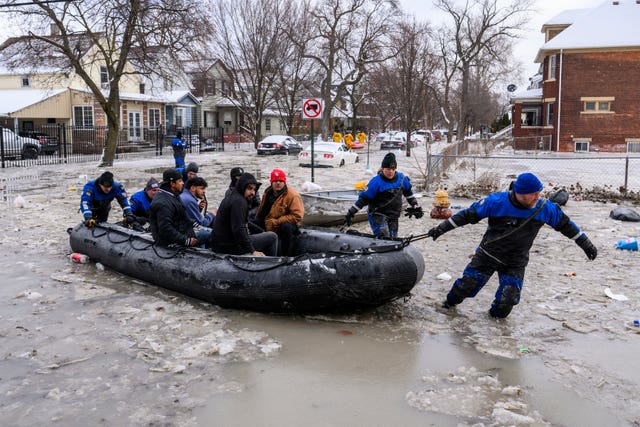‘Life-threatening cold’ hits parts of US following deadly weekend flooding
Meteorologists had predicted that parts of the US would experience the 10th and coldest polar vortex event this season.

Harsh cold descended on the middle of the US on Monday as a polar vortex gripped the Rockies and Northern Plains on the heels of weekend storms that pummelled the nation’s east with floods, killing at least 14 people.
The National Weather Service warned of “life-threatening cold” as wind chills dropped to minus 60 Fahrenheit (minus 51C) in parts of North Dakota on Monday and minus 50F (minus 46C) in parts of Montana. Tuesday morning was forecast to be even colder.
Extreme cold warnings were issued for an 11-state swath of the US stretching from the Canadian border to Oklahoma and central Texas, where the Arctic front was expected to bring near-record cold temperatures and wind chills in the single digits by midweek.
Meteorologists had predicted that parts of the US would experience the 10th and coldest polar vortex event this season. Weather forces in the Arctic are pushing chilly air that usually stays near the North Pole into the US and Europe.
The death toll in flood-battered Kentucky rose to 12, governor Andy Beshear said on Monday night. Two fatal vehicle crashes were connected to the severe weather, he said, and at least 1,000 people stranded by floods had to be rescued.
Parts of Kentucky and Tennessee received up to six inches (15 centimetres) of rain as severe storms swept across the South. Water submerged cars and buildings in Kentucky and mudslides blocked roads in Virginia.
In West Virginia, where there was one confirmed fatality with several people still missing, governor Patrick Morrisey asked President Donald Trump to issue a disaster declaration for a 13-county region ravaged by flooding.
Near Logan, West Virginia, authorities responded on Monday night to the spill of acidic water from an abandoned coal mine. The mine blowout damaged a road, making it impassable, fire officials said.
In Atlanta, a person was killed when a large tree fell on a home early on Sunday.
Flood warnings were extended on Monday across most of Kentucky and portions of Arkansas, Tennessee, Mississippi, Alabama, West Virginia, Virginia and Ohio.
In Nebraska, where much of the state was under a winter weather advisory, a state trooper was killed on Monday morning while responding to a crash on Interstate 80 near the town of Greenwood. The trooper’s name and further circumstances of the fatality were not immediately released.
Ice and snow made travel treacherous in large swaths of Michigan, which remained under a winter weather advisory until Monday afternoon.
Authorities in Colorado reported eight people were killed in fatal vehicle crashes since Valentine’s Day and warned drivers to be cautious.
Avalanche warnings were issued for numerous areas of the Rocky Mountains, with the danger rated high in portions of Colorado, Utah, Idaho and Wyoming.
The Mount Washington Avalanche Centre issued an avalanche warning on Monday for areas of the White Mountains in New Hampshire. Two ice climbers were rescued in the White Mountains on Sunday after triggering an avalanche that partially buried one of them, officials said.
Parts of a southwest Detroit neighbourhood were submerged after a nearly century-old water main burst on Monday, flooding streets, sidewalks and yards under several feet of water.

Firefighters used a ladder to help one person from the roof of a car in waist-deep water and a bulldozer was used to navigate a flooded street and help people leave a home, according to the fire department.
The 54-inch (137-centimetre) transmission main was built in 1930, according to the Great Lakes Water Authority.
Crews were attempting to isolate the break. It was not clear what caused it, but overnight temperatures had been well below freezing. No injuries have been reported.
This is the coldest month of the year for many locations, and air temperatures may approach record lows in some areas, said National Weather Service meteorologist Jason Anglin.
People should cover exposed skin and limit time outside to avoid frostbite, which can happen in minutes in such low temperatures, Mr Anglin said. Neighbours should check on each other and those who are vulnerable and monitor heater vents to make sure they do not ice up.
Due to the frigid conditions and a “lack of adequate heating fuel”, North Dakota governor Kelly Armstrong on Monday waived hours-of-service requirements for commercial-vehicle drivers hauling propane and petroleum products. The waiver is for 30 days.
The cold snap in North Dakota was expected to reduce oil production by about 5%, or about 50,000 to 80,000 barrels a day — pretty typical for such conditions, North Dakota Pipeline Authority director Justin Kringstad said. It takes about a week once temperatures warm up for volumes to rebound, he said.





